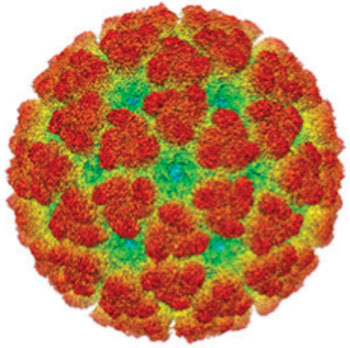Broadly Neutralizing Antibodies Protect Mice from Alphavirus Infection
By LabMedica International staff writers
Posted on 24 Nov 2015
While screening a panel of mouse and human monoclonal antibodies (MAbs) that had been raised against Chikungunya virus, researchers identified several with inhibitory activity against multiple other arthritogenic alphaviruses.Posted on 24 Nov 2015
The arthritogenic alphaviruses, which include Chikungunya virus, Mayaro virus, and O’nyong-nyong virus among others, characteristically cause symptoms of fever followed by arthritis-like joint pain. Currently there is no vaccine or treatment for chikungunya or the other alphaviruses.

Image: Cryoelectron micrograph reconstruction of the Chikungunya virus (Photo courtesy of the Washington University School of Medicine).
Investigators at the Washington University School of Medicine (St. Louis, MO, USA) screened 60 neutralizing mouse and human anti-chikungunya monoclonal antibodies and determined that 10 also recognized three or more different arthritogenic alphaviruses. Passive transfer of these "broadly neutralizing" MAbs protected mice against infection by chikungunya, Mayaro, and O’nyong’nyong alphaviruses.
The investigators reported in the November 6, 2015, online edition of the journal Cell that the broadly neutralizing MAbs blocked multiple steps in the viral lifecycle, including entry into host cells and egress. The antibodies were shown to bind to a conserved epitope on the B domain of the viral E2 glycoprotein. The cryoelectron microscopy structure of a Fab fragment bound to the chikungunya E2 B domain determined at 1.6 nanometer resolution showed that antibody binding caused the repositioning of the A domain of E2 so that it was able to cross-link neighboring spikes. This change in the three-dimensional structure of the proteins on the surface of the virus explained how the antibodies were able to prevent viral infection.
“There is a lot of emphasis on identifying and understanding broadly neutralizing antibodies for other viruses - HIV, Hepatitis C virus, Dengue virus, influenza virus - but most of those antibodies neutralize different strains of the same virus,” said senior author Dr. Michael Diamond, professor of medicine at the Washington University School of Medicine. “What we have identified here are antibodies that actually neutralize several different alphaviruses.”
“We have more work to do but are encouraged that targeting this epitope could be a viable strategy for developing vaccines or treatments against chikungunya and other related viruses that cause significant disease worldwide,” said Dr. Diamond. “If you can make an antibody response against this region, you may be able to protect against many viruses in the family. Our group is making proteins now that focus on this epitope, and we are planning to start immunizing animals soon to see if we generate the right kinds of antibodies.”
Related Links:
Washington University School of Medicine













